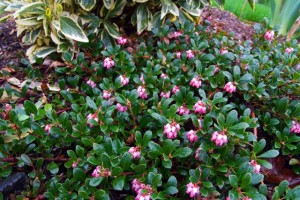Fire-resistant landscapes – creating a defensible space around your home
Posted on August 20th, 2012 by Andy
Wildfires raging throughout the West have gotten us thinking a lot about fire-resistant landscapes and how homeowners can help protect their homes from wildfires. Lightning often start fires but so, too, do people. Wildfires can start from campfires that aren’t properly put out, home sites that aren’t well maintained, and vehicles or equipment that create sparks.

Native kinnikinnick is one of dozens of plants considered “fire-resistant.”
There’s a lot of good information out there about how to protect your home from wildfires. Among the top recommendations is to create a “defensible space” around your home, or a safety zone of about 30-feet around your home and all structures. This is especially important for rural homeowners who live in areas where forests meet the edges of communities. The 30-foot safety zone should be clean, free of dead plant material and lean. Fire officials say to rake up dry leaves around the house and under decks and porches; prune trees away from homes; keep roof and gutters clear of flammable debris; and use fire-resistant plants where possible. Check out this brochure from King County for a good illustration of the different zones you should keep around your house.
The Washington’s Department of Natural Resources also offers these techniques for creating a defensible space around your home:
Use plants with high moisture content (deciduous) nearest the home.
Trim tree branches away from the home.
Prune trees at least six feet above the ground to reduce the changes that a fire on the ground will spread into tree tops. This is important if you have a lot of trees on your property.
King County has a great native plant database where you can search for different types of native plants that considered fire-resistant. Fire-resistant plants are described as ones where you get little seasonal accumulation of dead vegetation; have loose branching habits and are non-resinous if they’re woody plants. (Resinous trees include cedar, spruce, fir and pine). Many fire-resistant plants are also native to Washington, which make them easier to care for and less susceptible to diseases.
Some examples of fire-resistant trees for the Puget Sound area: cottonwood, maple, birch, cherry, flowering dogwood, vine maple, and crab apple. Fire-resistant shrubs include: Oregon grape, serviceberry, salal, mock orange, rhododendron, azalea, nootka rose. Good perennial choices include yarrow, hosta, iris, geranium, trillium, lamb’s ear, beard tongue and coreopsis. Groundcovers in this category include hens and chicks, stonecrop, verbenia, winter creeper and kinnikinnick.
In this video, local gardener Cisco Morris talks about how to create fire-resistant homes.
Contact Ecoyards to setup a consultation if you are looking for help with landscape plans for your property.
Filed under:Seattle Landscape Design, Seattle Landscape Maintenance | Permalink |



